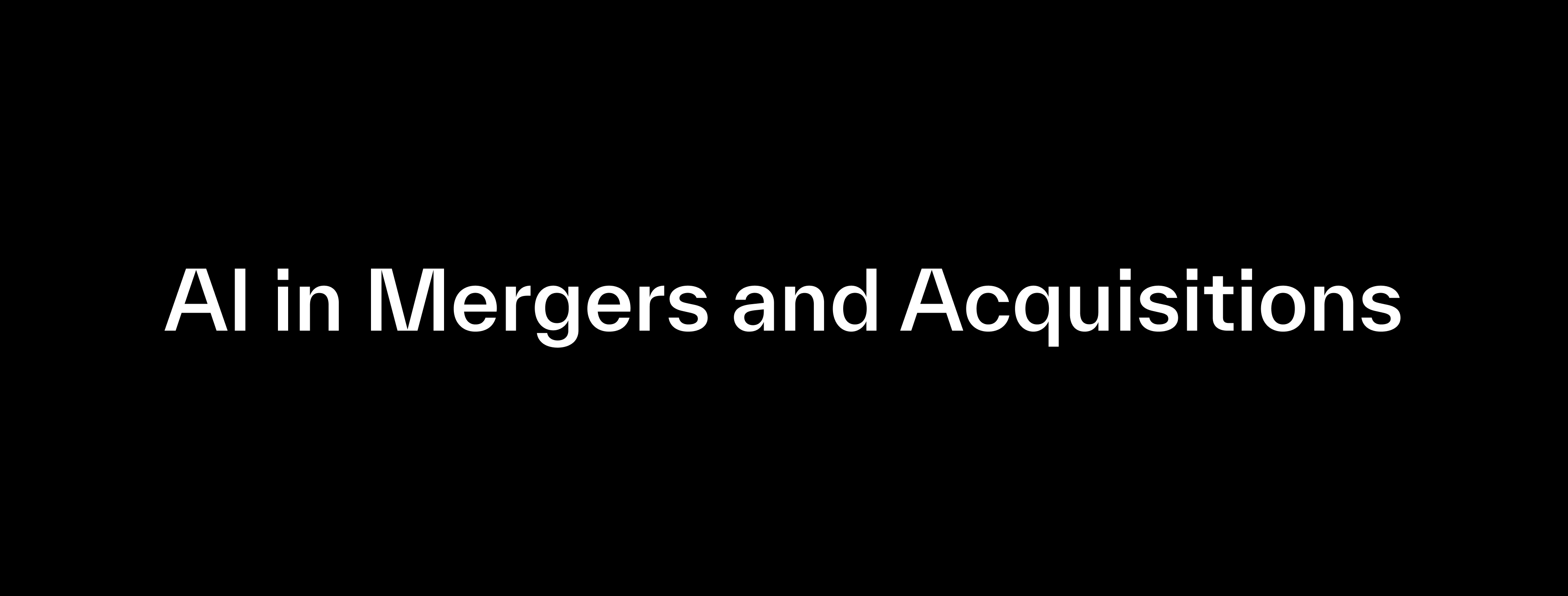AI in Mergers and Acquisitions

Key Points
- AI accelerates due diligence through real-time financial, legal, and operational data analysis.
- Transparent AI models reduce risk, bias, and blind spots in deal evaluation.
- Predictive analytics align M&A targets with market potential.
- AI tools support scalable post-merger integration across business functions.
- Leadership alignment ensures the ethical and strategic use of AI in high-stakes deals.
Market Momentum
Mergers and acquisitions have long been growth, scale, and transformation levers. But as deal complexity rises and timelines tighten, traditional M&A methods are showing their limits. Enter AI: a tool for automation, insight, acceleration, and competitive advantage.
AI is now a strategic imperative in M&A, redefining how companies identify targets, conduct due diligence, and execute integration. From early-stage screening to cultural alignment and post-deal optimization, AI is changing the tempo and texture of dealmaking. For CFOs, Chief Strategy Officers (CSOs), and deal sponsors, this is a pivotal moment to lead with intelligence, ensuring decisions are fast, informed, and future-ready.
Strategic Lens
AI is reengineering M&A from reactive document review to proactive, predictive strategy. Traditionally, due diligence relied on manually reviewing financial statements, contracts, IP assets, HR files, and compliance histories. This approach is labor-intensive and prone to oversight. AI flips the script.
Modern AI tools such as natural language processing (NLP) and machine learning can analyze thousands of contracts or emails in minutes, extracting anomalies, obligations, and legal risks. Predictive models can forecast future EBITDA contributions or churn risks based on customer data. Advanced simulations help model cultural alignment, an often overlooked driver of post-deal success.
By embedding AI into core deal activities, companies move from due diligence to true diligence: data-rich, real-time, and strategically aligned.
Growth Value Drivers
Integrating AI into M&A isn’t just a process improvement; it’s a value-creation revolution. Executives must understand and activate the key growth drivers AI unlocks to stay competitive in a fast-moving deal environment.
M&A cycles are increasingly driven by data, not just gut instinct. In an era of real-time analytics, dealmakers can scan market conditions and competitor moves to target company performance with surgical precision. AI platforms help firms identify under-the-radar acquisition targets based on growth patterns, funding signals, or strategic adjacency.
AI brings both opportunity and accountability. While it enables faster, sharper decision-making, it also exposes the need for greater governance. Inappropriate model training data, overlooked compliance triggers, or opaque algorithms could lead to missteps or regulatory scrutiny. As a result, AI must be applied ethically, with transparency around assumptions and limitations.
McKinsey found that companies using AI across the M&A lifecycle realize up to 30% faster deal execution and 20–25% higher ROI post-deal than traditional methods. But the gap widens significantly when companies fail to align AI with strategic imperatives or fail to interpret the data through a leadership lens.
The use of AI in M&A isn’t self-executing. It requires strong leadership to translate insight into action. CFOs must integrate financial models with AI output. CHROs must use predictive tools to assess workforce compatibility. Integration leaders must track post-close KPIs via AI dashboards. And all must uphold transparency and trust throughout the process.
AI can illuminate the path, but human leaders still choose the direction.
Executive Actions
AI changes not only how M&A is executed but also who is involved, when, and how. The role of the C-suite is to ensure that AI enhances rigor without eroding accountability and that technology augments judgment instead of replacing it.
Strategic questions:
- Are your M&A processes leveraging real-time, AI-enhanced data?
- Do your teams trust and understand AI insights in decision-making?
- Are ethical and regulatory frameworks in place for using AI in sensitive deal stages?
Immediate opportunities:
- Deploy AI tools for early-stage target screening using structured and unstructured market data.
- Integrate NLP platforms for contract analysis during due diligence to reduce legal exposure.
- Use machine learning to simulate integration scenarios, identifying likely bottlenecks or culture clashes.
Quarter-over-quarter priorities:
- Align deal teams, finance, HR, and IT around shared AI-enabled M&A workflows.
- Establish an M&A Center of Excellence to train teams on interpreting AI outputs and integrating them into playbooks.
- Develop transparent KPIs to evaluate post-deal performance using AI-driven insights across customer retention, margin expansion, or employee attrition.
The sooner AI becomes embedded in your M&A DNA, the faster and more effectively your organization can respond to opportunities.
Charting a New M&A Paradigm
If the past decade was about M&A scale, the next will be about M&A intelligence. Deals will be judged by size, precision, integration velocity, and long-term value realization, all of which AI is uniquely equipped to enhance.
AI doesn’t eliminate the art of dealmaking but adds science. It won’t replace CFOs, CSOs, or integration leaders but will reshape their toolkit and elevate their impact.
Organizations that integrate AI into their M&A playbook gain competitive separation, outpacing their peers in time-to-synergy, cultural alignment, and post-deal resilience. In a world where 70% of M&A deals fail to achieve expected value, AI may be the most important risk mitigation tool available.
The future of M&A is not just faster; it’s smarter. The question is: Are your deals built to win or just built to close?

